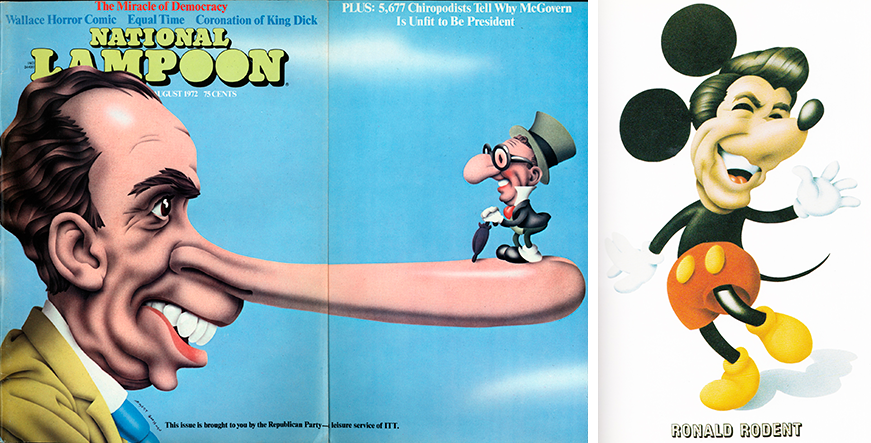
Grossman in his studio, 1968. Photo by Jan Welt.
A month or so before he passed away in his sleep on Thursday, March 15, I had dinner with Robert Grossman (1940-2018). True to his witty, acerbic, satiric self, he had those of us around the table in stitches as he recited his impromptu lyrics for a comic song about Donald J. Trump. He was genius at making anything rhyme and have comedic relevance too. I wish I had a recording device on the ready—or at least a better functional memory—because, as usual, his words were hilariously biting. Sadly, I don’t remember a single phrase. Bob had spot-on verbatim recall of just about any passage from any text he’d ever read that he then could relate to almost any topic of current interest. With his amazing memory, incredible ear and eye for topical humor, and firm grasp of history, Bob would make your head spin with delight.
Bob’s humor was of the infectious variety. Yet, his most recent comic strip, “TWUMP and POOTY”, a send-up of Punch and Judy, was never picked up by any magazine. (So I ran them on The Daily Heller.) It is hard to believe that when Bob’s wit was needed the most, it was ignored by today’s press. Our loss!
Bob’s death was unexpected. I felt kicked in the stomach when, on Friday morning, I read an email from his companion, Elaine Louie, announcing the tragic news. Certainly, there will be a slew of memorials, celebrations, and recollections about his life and art. He was not just good; he forever commands an essential place in caricature and satire history—and American humor, in general. So, for my part, this is not the obituary to lionize him; rather, it is a thank you, Bob.


Thank you for all of the work that made our powerful figures look mockingly absurd when they deserved it and poignantly human when they didn’t. Thank you for visual treats like your irreverent “Babe Lincoln.” Thank you for all those conceptually resplendent transfigurations of Richard Nixon, Ronald Reagan, and George Bush, not to mention your tweaks on Monica Lewinsky, Hillary Clinton, and dozens upon dozens more famous and infamous. Thanks for your enlightening conversations and dissertations on just about anything I could imagine. And thanks for never turning down a job I offered you, no matter how minor—it was major for me. Oh, and thanks for the caricature-sculpture you did of me.
Brooklyn-born, Grossman’s father was a sign painter. This may contribute to why, after Bob graduated from studying at Yale and working on its humor magazine, he decided to switch from gag cartoons to his more iconic illustrative method, the common airbrush. The airbrush was not new. Commercial artists had used it since the late 19th Century—mostly for retouching, but figuratively too. Grossman, however, transformed its smooth, streamlined gradients into a style, method, and unprecedented art form that altered the look of illustration in the 1960s. Others followed suit, but Grossman’s allure was not just style; he applied the balloon-like airbrush aesthetic to the serious themes in politics, race, religion, corruption, and more. His Nixon with a fold-out Pinocchio nose (with Henry Kissinger as Jiminy Cricket on its end) for the cover of National Lampoon was one of most savagely funny Watergate protests and possibly the most memorable. Bob knew better than anyone of his generation how to make ridicule that skewered its target while making the rest of his audience apoplectic with joy.


There are so many brilliant (and that word does not do them justice) caricatures and sculptures Bob made of the famous and infamous in all walks of life that one has to see them to believe how prodigious and indefatigable he was and how completely committed he was to the art.
When anyone dies, the finality of that presence is palpable. But when someone dies who had and continued to have so much talent to give, it is devastating. Bob’s passing will take time to reconcile, but his work is online and waiting to be made into a book. For many of us, certain pieces will continue to trigger memories of times and places, people and events. Bob Grossman’s art allows me to remember when illustration was profound and Bob was among the most profound of them all.



